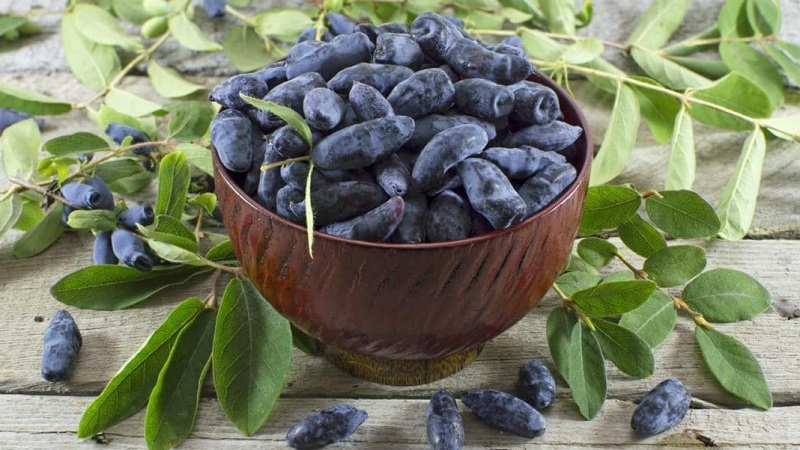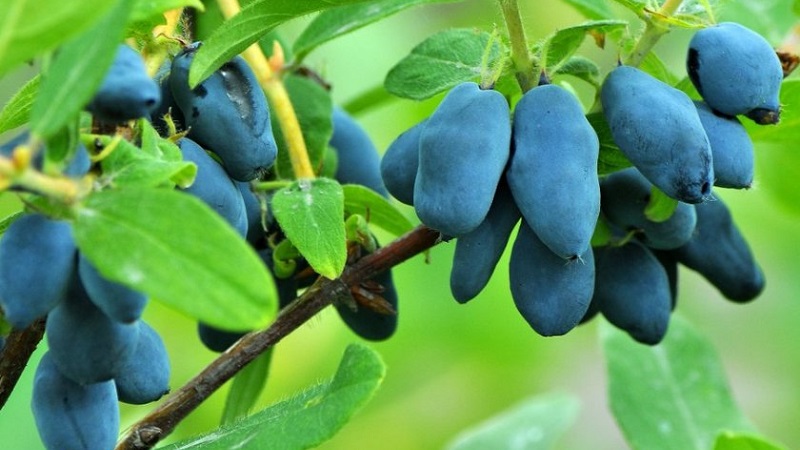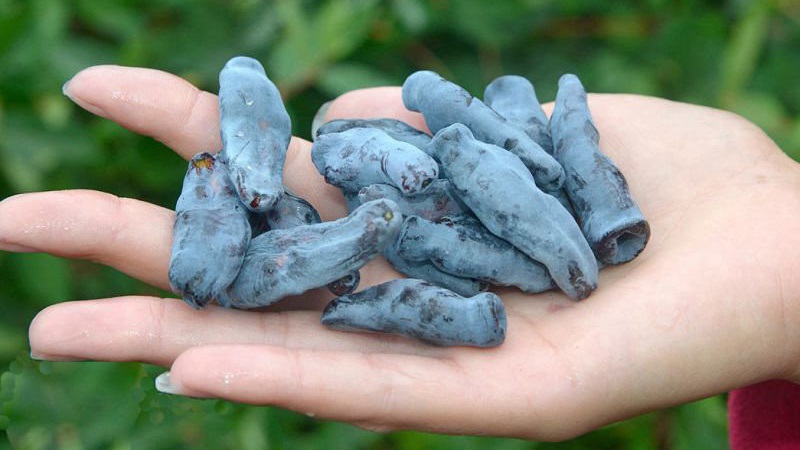What year does honeysuckle bear fruit after planting?
Edible honeysuckle is becoming more and more popular every season. Juicy oblong fruits are increasingly found in markets and shops. Many gardeners place more hope in this crop, but are often disappointed with the yield.
From the article you will find out when honeysuckle begins to bear fruit, how much it grows before fruiting, how to increase and maintain yields.
The content of the article
What year does honeysuckle bear fruit?

When does honeysuckle give its first fruits? Saplings begin to bear fruit 3-4 years after planting. If the shrub was propagated by cuttings, the berries appear after a year, but in this case, fruiting is poor. The first large harvest can only be harvested after 6-7 years. Gardeners collect 1-2 kg of honeysuckle berries from one bush. Some varieties enter the fruiting phase 1-2 years earlier.
Reference. The fruits of wild varieties of honeysuckle are bitter on taste, while the period of intensive fruiting often exceeds 50 years. Wild plants yield crops only 5-7 years after planting.
How many years does honeysuckle bear fruit?
The duration of fruiting is influenced by the honeysuckle variety. Some varieties are able to bear fruit for 12 years. The average varies from 5 to 7 years.
Aging of honeysuckle begins after 8-10 years of active vegetation, and the yield level gradually decreases. To maintain optimal fruiting, shrubs are pruned into a ball.
Honeysuckle fruiting time

When choosing a variety of honeysuckle, gardeners recommend paying attention to the period of growth, development and maturation. There are early, mid-early and late varieties.
The most popular varieties in domestic gardening and the timing of their fruiting are as follows:
- Long-fruited - early May;
- Swallow - mid-June;
- Blueberry - early July;
- Altair, Lazurite - mid-July;
- Chelyabinka - early August;
- My joy is mid to late August.
How to increase the fruiting of honeysuckle

Honeysuckle is one of the unpretentious shrubs, but sometimes even with proper care fruiting decreases. This happens for a number of reasons:
- lack of sunlight as a result of thickening plantings;
- frostbite of shoots due to returnable spring frosts;
- lack of pollinating insects, especially when the heat comes too early;
- nutritional deficiencies.
Sometimes there is a decrease in yield if the shrub is too young or too old.
The advice of experienced gardeners will help to increase the fruiting of honeysuckle:
- Pay attention to fruitful shrub varieties. Half of the success depends on this choice. The most productive varieties are considered: Lenita, Amazon, Arechnaya, Elizaveta, Maria, Long-fruited.
- Before planting seedlings, properly prepare the planting holes. The size of the pit should be 50x60x40 cm, add 10-20 liters of humus, 1 liter of ash, 30-50 g of superphosphate, 15 g of potassium salt to each of them. Add 3-5 liters of vermiculite to preserve moisture and soil structure.
- Plant different types of shrubs nearby. Up to 15 bushes can be placed on one site. This stimulates cross-pollination and increases yields. With proper planting, about 12 kg can be collected from one plant.
- Irrigate plants with sugar water (2 tablespoons granulated sugar per 10 liters of water) to attract pollinating insects.
- Control the acidity of the soil. The optimum pH is 5.5-6.5. Add slaked lime (400-500 g per 1 sq. M) to the soil with high acidity. Use gypsum (500 g / m2) for leaching.For the normal development of honeysuckle, loam and sandy loam are best suited. Loosen clogged, heavy clay soil with humus (10 liters per 1 sq. M) or river sand (bucket per 1 sq. M).
- Monitor moisture levels. Honeysuckle is a moisture-loving plant and needs regular watering during flowering and ripening of berries. When there is a shortage of water, the bushes shed flowers and ovaries, and the berries acquire a bitter taste. In May and June, one bush requires 4-5 buckets of settled water. Watering frequency depends on weather conditions and is 3-5 times a season.
- Perform a thinning haircut honeysuckle as the branches grow, starting from the sixth year of development. The optimal distance between the bushes should be 1.5-2 m, and the row spacing should be 2-2.5 m. For the first 3-5 years, the shrub does not need pruning. The optimal period for the procedure is late autumn.
- Don't forget in time fertilize plantings to maintain health and fruiting. A deficiency of nutrients slows down the ripening of fruits and provokes the addition of fungal infections. Fertilize honeysuckle with humus in spring, phosphorus in summer, and wood ash in autumn.
- When feeding bushes, do not overdo it. An excess of nutrients increases the number of shoots and leads to shading. The optimal amount of organic fertilizing is three times a year, 5-7 kg per bush. In the spring, plants are fertilized with ammonium nitrate - 30 g per 1 sq. m. In June, the second portion of fertilizers is introduced - 10 g of ammonium nitrate, 15 g of potassium nitrate, 15 g of double superphosphate per 1 sq. m. m. In the fall, under the digging to a depth of 10 m, 15 g of double superphosphate and potassium salt are added per 1 sq. m.
- To fight with insect pests use herbal infusions of garlic, mustard, tomato or potato tops, yarrow. Cover bushes with nets to protect crops from birds.
- Mulch the trunk circle with grass or humus... This will keep moisture in the soil.

Conclusion
In the article, we described the year after planting the honeysuckle bears fruit and how to maintain the optimal level of crop yield. Much depends on the variety you choose. Experienced gardeners recommend buying varieties Lenita, Amazonka, Arechnaya, Elizaveta, Maria, Dlinnoplodnaya, in order to get 1-2 kg of selected berries from a bush.
Before planting, you need to properly prepare the pits, choose a place with diffused lighting, water and fertilize plants in time, attract pollinating insects and fight pests. After each harvest, the honeysuckle bushes are rejuvenated by thinning.